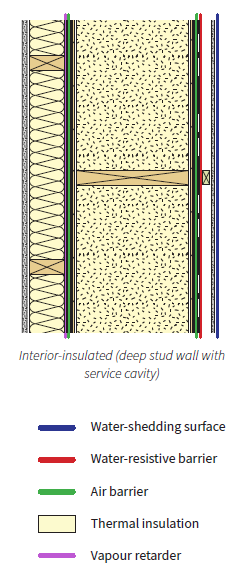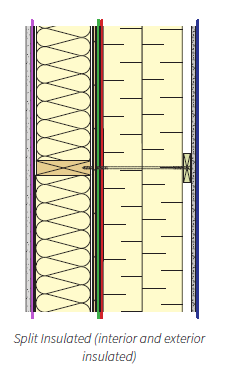Critical Barriers
The term critical barrier refers to materials and components that together perform a control function within the building enclosure.
The water-shedding surface (WSS) refers to the outer surface of assemblies, interfaces, and details that deflect or drain the vast majority of the exterior water off the assembly. For wall assemblies, the WSS is the cladding; wood siding, vinyl, masonry veneer, or a variety of other materials. For windows, the WSS is a combination of the outer portion of the frame, exterior gaskets, glazing tape, or sealant, and the insulating glass unit. For roofs it is the shingles, metal roofing, or membrane.
The water-resistive barrier (WRB) is the surface farthest inward from the exterior that can accommodate moisture without incurring damage to interior finishes or materials within the assembly. It is not always easy to establish this barrier since some surfaces can accommodate small amounts of moisture for a limited time without damage, while larger quantities of water or longer exposure to moisture will lead to premature deterioration or migration of moisture further into the assembly. For many wall assemblies, the WRB is the sheathing membrane in combination with flashing and sealants at penetrations.
The air barrier (AB) controls the flow of air through the elements of the building enclosure, either inward or outward. Airflow is a significant variable with respect to space conditioning costs, condensation control and rain penetration control. For most window frames, the WRB (and air barrier) is likely the interior portion of frame members in combination with gaskets, glazing tape, or sealants that are not directly exposed to the exterior. Note that the glazing in windows is the WSS, the WRB and the air barrier. This illustrates the general point that specific materials within an assembly may perform several critical barrier functions.
Another critical barrier is the vapour retarder (often called a vapour barrier/VB) whose role is to control the outward diffusion of moisture through an enclosure. It is often comprised of sheet polyethylene located behind the interior finish, but other solutions are possible, such as vapour retarding paint or certain types of rigid foam insulation.
The primary function of thermal insulation is to limit conductive heat flow out of the building, a significant aspect of the thermal performance and energy efficiency of the building enclosure. The thermal resistance and vapour permeability of the materials that make up an assembly must be considered in order to control condensation.
The building form and features, while not strictly defined as a critical barrier, refers to the shape and configuration of the building and the protection from exposure to water these can provide for the building enclosure assemblies and elements.

